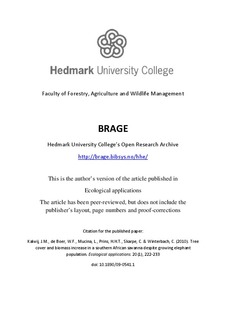Tree cover and biomass increase in a southern African savanna despite growing elephant population
Journal article, Peer reviewed
Permanent lenke
http://hdl.handle.net/11250/134256Utgivelsesdato
2010Metadata
Vis full innførselSamlinger
Originalversjon
Kalwij, J. M., de Boer,W. F., Mucina, L. , Prins, H. H. T., Skarpe, C. og Winterbach, C. (2010). Tree cover and biomass increase in a southern African savanna despite growing elephant population. Ecological Applications. 20 (1). 222—233. [doi:10.1890/09-0541.1]Sammendrag
The growing elephant populations in many parts of southern Africa raise concerns of a detrimental loss of trees, resulting in overall reduction of biodiversity and ecosystem functioning. Elephant distribution and density can be steered through artificial water points (AWPs). However, this leaves resident vegetation no relief during dry seasons. We studied how the introduction of eight AWPs in 1996 affected the spatiotemporal tree-structure dynamics in central Chobe National Park, an unfenced savanna area in northern Botswana with a dry-season elephant density of ;3.34 individuals per square kilometer. We hypothesized that the impact of these AWPs amplified over time and expanded in space, resulting in a decrease in average tree density, tree height, and canopy volume. We measured height and canopy dimensions of all woody plants around eight artificial and two seasonal water points for 172 plots in 1997, 2000, and 2008. Plots, consisting of 50 3 2 m transects for small trees (0.20–3.00 m tall) nested within 50 3 20 m transects for large trees (≥3.0 m tall), were located at 100, 500, 1000, 2000, and 5000 m distance classes. A repeated-measures mixed effect
model showed that tree density, cover, and volume had increased over time throughout the area, caused by a combination of an increase of trees in lower size classes and a decrease in larger size classes. Our results indicate that the decrease of large trees can be attributed to a growing elephant population. Decrease or loss of particular tree size classes may have been caused by a loss of browser-preferred species while facilitating the competitiveness of less preferred species. In spite of 12 years of artificial water supply and an annual elephant population growth of 6%, we found no evidence that the eight AWPs had a negative effect on tree biomass or tree structure. The decreasing large-tree component could be a remainder of a depleted but currently restoring elephant population.
Beskrivelse
Copyright by the Ecological Society of America
